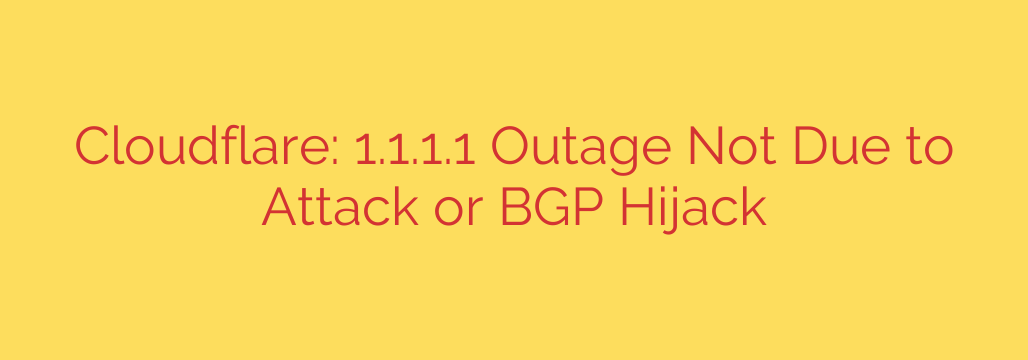
What Really Happened During the Major 1.1.1.1 DNS Outage?
If you recently found yourself unable to connect to your favorite websites, you weren’t alone. A widespread disruption to the popular 1.1.1.1 public DNS resolver caused significant connectivity issues for users across the globe, making large parts of the internet temporarily inaccessible. When an outage of this scale occurs, speculation often turns to malicious activity. However, initial fears of a coordinated cyberattack were quickly dispelled.
The investigation confirmed that the service interruption was not the result of outside interference. Let’s break down what happened and what it means for the stability of our internet infrastructure.
Dispelling the Rumors: Not a Cyberattack or BGP Hijack
In the world of internet infrastructure, the first suspects in a massive, sudden outage are often a Distributed Denial of Service (DDoS) attack or a Border Gateway Protocol (BGP) hijack. A DDoS attack floods a service with so much traffic that it becomes overwhelmed and unresponsive. A BGP hijack maliciously reroutes internet traffic, effectively kidnapping a service’s digital address.
Fortunately, analysis of the event showed that neither of these scenarios was the culprit. The outage was not caused by any malicious attack or external threat. This is a crucial distinction, as it points to an internal failure rather than a vulnerability exploited by bad actors. For users, this means their data and security were never directly at risk from an external breach during the incident.
The Root Cause: A Flaw in Network Configuration
So, if it wasn’t an attack, what brought the service down? The disruption was traced back to a problem within the internal network architecture. Specifically, the issue stemmed from a flaw related to the routers that manage traffic for the 1.1.1.1 service.
Think of it like the air traffic control system for a major international airport. If a critical piece of routing software is updated with a faulty command, it can instruct planes (or in this case, data packets) to go to the wrong place—or nowhere at all. This creates a massive traffic jam that brings everything to a halt.
The core of the problem was an internal configuration error that caused a cascading failure across the network. Once engineers identified the problematic configuration, they were able to roll back the change and restore normal traffic flow. The rapid identification and resolution highlight the importance of robust internal monitoring and response protocols.
Actionable Security Tips for Future Internet Outages
While this specific outage was resolved quickly, it serves as a powerful reminder of how dependent we are on single services. No system is infallible, so it’s wise to have a backup plan.
Here are a few practical steps you can take to stay connected during the next DNS outage:
- Configure a Secondary DNS Resolver: Your device or home router can be configured with more than one DNS provider. If your primary choice (like 1.1.1.1) goes down, your system can automatically switch to a secondary one. Popular and reliable alternatives include Google Public DNS (8.8.8.8) and Quad9 (9.9.9.9). Setting up a backup DNS is the single most effective way to protect yourself from these types of outages.
- Bookmark Official Status Pages: Major service providers maintain status pages that provide real-time updates during an outage. Bookmark the status pages for your critical services (DNS, cloud providers, etc.). This allows you to quickly verify if an issue is with your own connection or a wider problem.
- Understand the Symptoms: If multiple, unrelated websites suddenly fail to load, but your Wi-Fi signal is strong, it’s often a sign of a DNS problem. Knowing this can save you the frustration of rebooting your router repeatedly when the issue lies elsewhere.
Lessons in Internet Resilience
This incident underscores the complex and sometimes fragile nature of the internet’s core infrastructure. Even the most resilient systems can be temporarily impacted by a simple configuration mistake. The key takeaways are the importance of transparency in incident reporting and the value of building redundancy into your own digital life. By understanding what happened and preparing for the future, we can all navigate the digital world a little more smoothly.
Source: https://www.bleepingcomputer.com/news/security/cloudflare-says-1111-outage-not-caused-by-attack-or-bgp-hijack/








